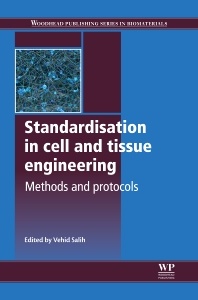Description
Standardisation in Cell and Tissue Engineering
Methods and Protocols
Woodhead Publishing Series in Biomaterials Series
Coordinator: Salih V
Language: English
Subjects for Standardisation in Cell and Tissue Engineering:
276 p. · 15.5x23.3 cm · Hardback
Out of Print
Description
/li>Contents
/li>Biography
/li>Comment
/li>
Part one provides an overview of methods for cell and tissue engineering and includes chapters on the fundamentals of cell and matrix biology for tissue engineering, 3D collagen biomatrix development, and control and vascularisation of tissue-engineered constructs. Part two begins with a chapter exploring the methods and protocols of standardisation in cell and tissue engineering before moving on to highlight issues of quality control in cell and tissue engineering, standardised chemical analysis and testing of biomaterials and principles of good laboratory practice (GLP) for in vitro cell culture applications.
Standardisation in cell and tissue engineering is a standard reference for leading research groups, government agencies, regulatory bodies, and researchers and technicians at all levels across the whole range of disciplines using cell culture within the pharmaceutical, biotechnology and biomedical industries.
Contributor contact details
Woodhead Publishing Series in Biomaterials
Foreword
Introduction
Part I: Methods for cell and tissue engineering
Chapter 1: Fundamentals of cell and matrix biology for tissue engineering
Abstract:
1.1 Introduction
1.2 Extracellular matrices (ECMs)
1.3 ECM and cell interaction
1.4 ECM and mechanical signalling
1.5 Future trends
1.6 Conclusion
Chapter 2: Three-dimensional collagen biomatrix development and control
Abstract:
2.1 Engineering cell-rich and matrix-rich tissues using collagen scaffolds
2.2 Controlling the mechanical properties of collagen
2.3 Architectural features: introducing elements of tissue complexity
2.4 Future trends
Chapter 3: Two- and three-dimensional tissue culture bioprocessing methods for soft tissue engineering
Abstract:
3.1 Introduction
3.2 Bioreactor configurations
3.3 Selecting scaffold materials and architectures for your bioreactor
3.4 Mass transfer in tissue engineering bioreactors
3.5 Important parameters and taking measurements of bioreactor cultures
3.6 Tissue engineering process design
3.7 Future trends
3.8 Conclusion
3.9 Sources of further information and advice
Chapter 4: Two- and three-dimensional tissue culture methods for hard tissue engineering
Abstract:
4.1 Introduction
4.2 Culture of bone and cartilage cells
4.3 Cell culture parameters: bone tissue culture
4.4 Cell culture parameters: cartilage tissue culture
4.5 Two-dimensional tissue culture methods for hard tissues
4.6 Two-and-a-half- and three-dimensional tissue culture methods for hard tissues
4.7 Conclusion
Chapter 5: Vascularisation of tissue-engineered constructs
Abstract:
5.1 Introduction
5.2 Growth of healthy vessels ‒ embryonic vasculogenesis
5.3 Angiogenic diseases
5.4 Angiogenesis and bone formation
5.5 Cell sources for vascular tissue engineering
5.6 Co-culture of cells: the interactions between angiogenesis and osteogenesis
5.7 Strategies to induce in vitro prevascularisation
5.8 Tubular formation
5.9 Conclusion
Part II: Standards and protocols in cell and tissue engineering
Chapter 6: Standards in cell and tissue engineering
Abstract:
6.1 Introduction
6.2 How and by whom are standards produced?
6.3 The importance of an agreed lexicon
6.4 Drivers for standardization
6.5 How will standards help me?
6.6 What standards currently exist in tissue engineering?
6.7 Characterization of biomaterials and biomolecules
6.8 Characterization of tissue scaffolds
6.9 Characterization of cell-seeded scaffolds
6.10 Manufacture, processing and storage
6.11 Characterization of cells and cell-surface interactions
6.12 Conclusion
Chapter 7: Principles of good laboratory practice (GLP) for in vitro cell culture applications
Abstract:
7.1 Introduction
7.2 GLP governing bodies
7.3 Resources required for GLP compliance
7.4 Characterisation
7.5 Standards and regulations
7.6 Documentation of results
7.7 Independent monitoring of research processes and quality assurance (QA) personnel
7.8 Application of GLP to human cell culture systems
7.9 Conclusion
7.10 Acknowledgements
Chapter 8: Quality control in cell and tissue engineering
Abstract:
8.1 Introduction
8.2 Quality control to ensure a well-defined cell therapy product
8.3 Commercial quality control/quality assurance in large-scale manufacture
8.4 Conclusion
Chapter 9: Standardised chemical analysis and testing of biomaterials
Abstract:
9.1 Introduction: why we need standard methods for testing biomaterials
9.2 Standardised chemical analysis: when and why we assess chemistries
9.3 Chemical properties
9.4 Imaging methods for measuring porosity
9.5 Physical characterisation – permeability
9.6 Surface properties
9.7 Degradation and stability in physiological fluids
9.8 Implant–tissue interface tests
9.9 Limitations of current standardised testing methods
Chapter 10: Sterilisation procedures for tissue allografts
Abstract:
10.1 Introduction
10.2 Interaction of ionising radiation with matter
10.3 Sources of ionising radiation
10.4 Validation and international standards of sterilisation by ionising radiation
10.5 Conclusions and future trends
10.6 Sources of further information and advice
Chapter 11: Commercial manufacture of cell therapies
Abstract:
11.1 Introduction: cells as therapies
11.2 The transition from laboratory to commercial- scale manufacture of cell therapies
11.3 Key regulatory requirements for commercial manufacture of cell therapies
11.4 Cell-based therapy versus monoclonal antibody therapies: lessons from existing biopharmaceutical manufacture
11.5 Conclusion
Index
- Introduces concepts and current practice in the field of cell and tissue engineering
- Highlights the importance of standardisation in cell and tissue engineering and suggests directions for further investigation
- Explores methods and protocols of standardisation in cell and tissue engineering and issues of quality control in cell and tissue engineering
These books may interest you

Cell and Tissue Engineering 105.49 €



